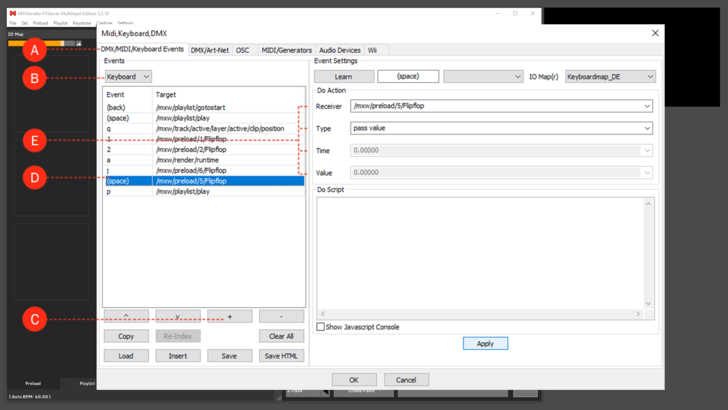About Events: Difference between revisions
Jump to navigation
Jump to search
No edit summary |
No edit summary |
||
| (One intermediate revision by the same user not shown) | |||
| Line 1: | Line 1: | ||
MXWendler enables you to trigger a whole series of events and animations with a keystroke or a MIDI/DMX event. All events work according to the same principle: a trigger activates an event, which sends a specific value to a receiver at a specific time. | |||
Events are managed in the IO | Events are managed in the IO Devices Settings: | ||
1. Open 'DMX/MIDI/Keyboard Events' in the settings: '''(A)''' | |||
:'''Menu: Settings → IO Devices → DMX/MIDI/Keyboard Events''' | |||
2. Determine the trigger by selecting the respective tool: DMX, MIDI, Keyboard, Timer or TUIO (also Wii running Windows). '''(B)''' | |||
3. Create an event with the '+' button. '''(C)''' | |||
4. Activate an event. '''(D)''' | |||
5. Specify the various event settings (receiver / event type / time / value). '''(E)''' | |||
[[File:Events_1.png|728px]] | [[File:Events_1.png|728px]] | ||
Latest revision as of 09:38, 1 October 2019
MXWendler enables you to trigger a whole series of events and animations with a keystroke or a MIDI/DMX event. All events work according to the same principle: a trigger activates an event, which sends a specific value to a receiver at a specific time.
Events are managed in the IO Devices Settings:
1. Open 'DMX/MIDI/Keyboard Events' in the settings: (A)
- Menu: Settings → IO Devices → DMX/MIDI/Keyboard Events
2. Determine the trigger by selecting the respective tool: DMX, MIDI, Keyboard, Timer or TUIO (also Wii running Windows). (B)
3. Create an event with the '+' button. (C)
4. Activate an event. (D)
5. Specify the various event settings (receiver / event type / time / value). (E)
